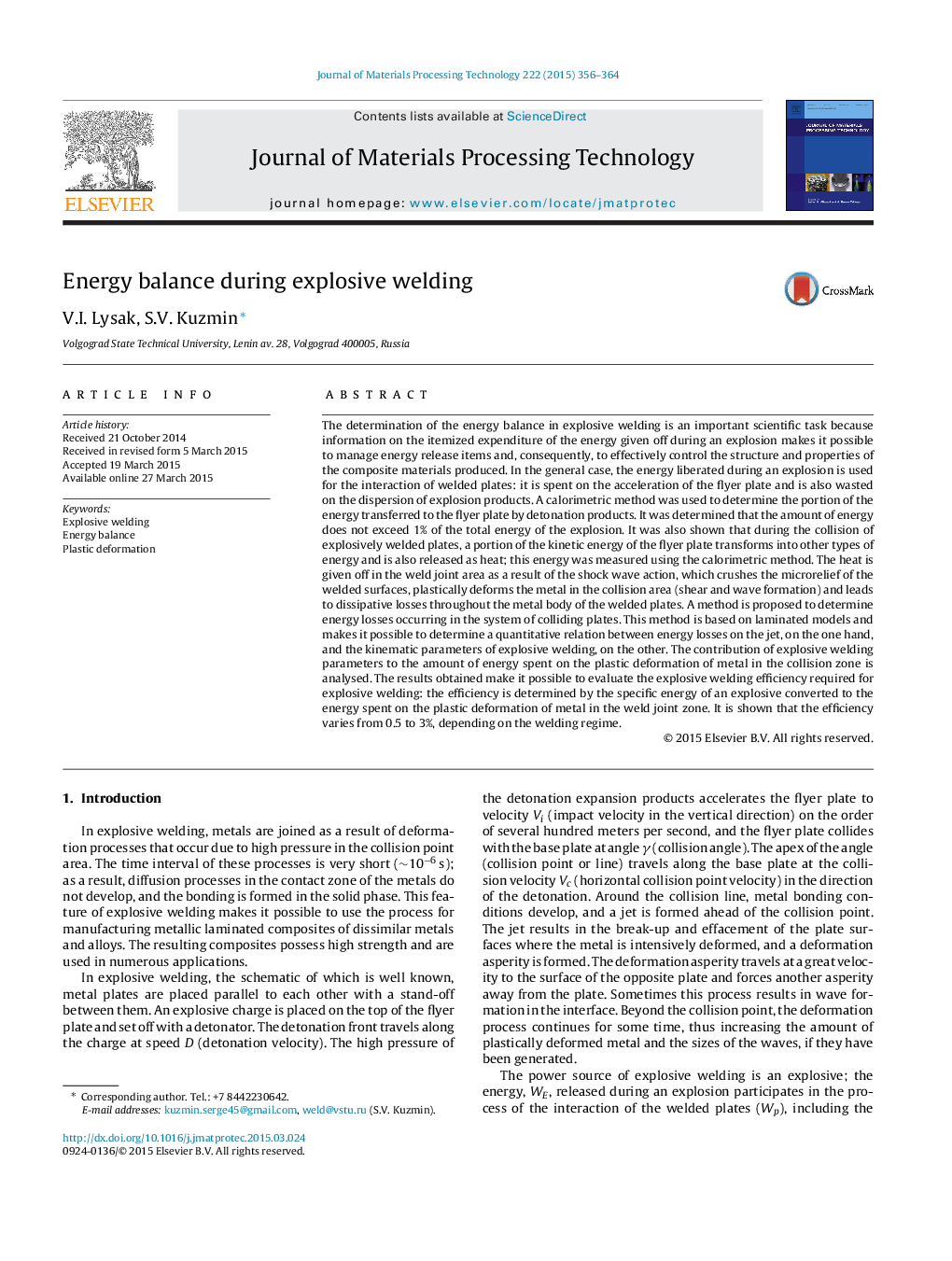| کد مقاله | کد نشریه | سال انتشار | مقاله انگلیسی | نسخه تمام متن |
|---|---|---|---|---|
| 7177088 | 1466745 | 2015 | 9 صفحه PDF | دانلود رایگان |
عنوان انگلیسی مقاله ISI
Energy balance during explosive welding
ترجمه فارسی عنوان
تعادل انرژی در طی جوشکاری انفجاری
دانلود مقاله + سفارش ترجمه
دانلود مقاله ISI انگلیسی
رایگان برای ایرانیان
کلمات کلیدی
جوشکاری انفجاری، تعادل انرژی، تغییر شکل پلاستیک
ترجمه چکیده
تعیین تعادل انرژی در جوشکاری انفجاری، یک وظیفه مهم علمی است؛ زیرا اطلاعات مربوط به هزینه های مشخص شده انرژی که در طی انفجار داده شده است، امکان مدیریت اقلام تولید انرژی را فراهم می کند و در نتیجه به طور موثر کنترل ساختار و خواص کامپوزیت مواد تولید شده. در مورد کلی، انرژی در طول انفجار آزاد شده، برای تعامل با صفحات جوش داده شده استفاده می شود: در شتاب ورق فلیکر صرف شده است و همچنین بر روی پراکندگی محصولات انفجاری هدر رفته است. یک روش کالریمتریک برای تعیین بخش انرژی که به وسیله محصولات انفجاری به صفحه ورق برگردانده شده است. تعیین شد که مقدار انرژی از 1٪ کل انرژی انفجار تجاوز نمی کند. همچنین نشان داده شده است که در طی برخورد صفحات جوش داده شده انفجاری، بخشی از انرژی جنبشی ورق فلیر به سایر انواع انرژی تبدیل می شود و همچنین به عنوان گرما آزاد می شود. این انرژی با استفاده از روش کالریمتریک اندازه گیری شد. گرما در ناحیه اتصال جوش داده می شود به عنوان یک نتیجه از عمل موج موج، که خردایش سطوح جوش داده شده را خرد می کند، فلزی در منطقه برخورد (شکل برش و موج) تغییر شکل می دهد و منجر به زیان های تخریبی در سراسر فلز بدن از صفحات جوش داده شده. یک روش برای تعیین ضایعات انرژی در سیستم صفحات برخورد شده پیشنهاد شده است. این روش بر اساس مدل های لایه ای است و امکان تعیین ارتباط کمی بین زیان های انرژی در جت از یک طرف و پارامترهای سینماتیک جوشکاری انفجاری را از سوی دیگر فراهم می کند. سهم پارامترهای جوشکاری انفجاری در مقدار انرژی مصرفی در تغییر شکل پلاستیک فلز در منطقه برخورد، مورد تجزیه و تحلیل قرار گرفته است. نتایج به دست آمده امکان سنجی کارایی جوشکاری مواد منفجره مورد نیاز برای جوشکاری انفجاری را ارزیابی می کند: بهره وری توسط انرژی خاصی از یک ماده منفجره تبدیل شده به انرژی مصرف شده در تغییر شکل پلاستیک فلز در ناحیه اتصال جوش تعیین می شود. نشان داده شده است که کارایی آن از 5/0 تا 3 درصد بسته به رژیم جوشکاری متفاوت است.
موضوعات مرتبط
مهندسی و علوم پایه
سایر رشته های مهندسی
مهندسی صنعتی و تولید
چکیده انگلیسی
The determination of the energy balance in explosive welding is an important scientific task because information on the itemized expenditure of the energy given off during an explosion makes it possible to manage energy release items and, consequently, to effectively control the structure and properties of the composite materials produced. In the general case, the energy liberated during an explosion is used for the interaction of welded plates: it is spent on the acceleration of the flyer plate and is also wasted on the dispersion of explosion products. A calorimetric method was used to determine the portion of the energy transferred to the flyer plate by detonation products. It was determined that the amount of energy does not exceed 1% of the total energy of the explosion. It was also shown that during the collision of explosively welded plates, a portion of the kinetic energy of the flyer plate transforms into other types of energy and is also released as heat; this energy was measured using the calorimetric method. The heat is given off in the weld joint area as a result of the shock wave action, which crushes the microrelief of the welded surfaces, plastically deforms the metal in the collision area (shear and wave formation) and leads to dissipative losses throughout the metal body of the welded plates. A method is proposed to determine energy losses occurring in the system of colliding plates. This method is based on laminated models and makes it possible to determine a quantitative relation between energy losses on the jet, on the one hand, and the kinematic parameters of explosive welding, on the other. The contribution of explosive welding parameters to the amount of energy spent on the plastic deformation of metal in the collision zone is analysed. The results obtained make it possible to evaluate the explosive welding efficiency required for explosive welding: the efficiency is determined by the specific energy of an explosive converted to the energy spent on the plastic deformation of metal in the weld joint zone. It is shown that the efficiency varies from 0.5 to 3%, depending on the welding regime.
ناشر
Database: Elsevier - ScienceDirect (ساینس دایرکت)
Journal: Journal of Materials Processing Technology - Volume 222, August 2015, Pages 356-364
Journal: Journal of Materials Processing Technology - Volume 222, August 2015, Pages 356-364
نویسندگان
V.I. Lysak, S.V. Kuzmin,
